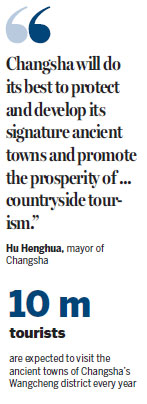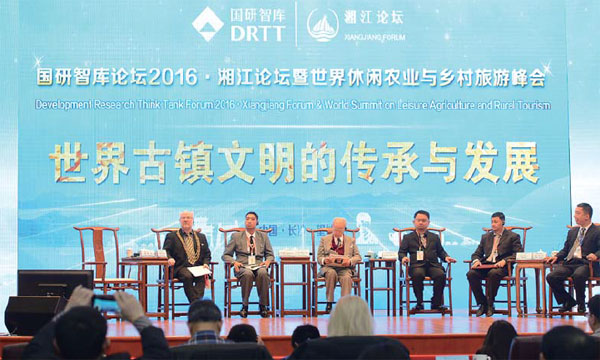Ancient river towns revitalized
Hunan capital implements three-year plan to bring in big tourism revenue, Zhang Zhouxiang reports.
Hunan province's capital city, Changsha, has been endeavoring to revitalize a group of ancient towns along the Xiangjiang River in recent years.
Changsha has deployed a three-year action plan to establish a tourism cluster for the characteristic heritage region in Wangcheng district, located in the northern part of the Xiangjiang River.
Before the invention of modern transportation, water shipping was the most efficient and cost-effective mode of transportation. The ancient towns along the banks of the river - namely Jinggang, Qiaokou, Xinkang, Tongguan, Shutang and Dingzi - served as trading ports and each fostered their own culture.
According to the plan, Changsha will speed up the development of the area's tourism by building a 5A tourism region out of the above-mentioned towns, encompassing a charming region of 20,000 hectares by 2018. The region is expected to host 10 million tourists every year, generating a staggering revenue of 10 billion yuan ($1.45 billion) annually.
The government has designed the city as a holistic tourism cluster, with each town developing its own features to provide the tourists with an immersive cultural experience.

Among the ancient towns, Jinggang, an important town in terms of trade and military significance, has renovated and recovered some of its ancient-style architecture and shops, and built a number of traditional snack brands.
Tongguan has been known for its porcelain production since the Tang Dynasty (618-907). It was also the origin of the underglaze coloring technique. Tongguan has successfully been revitalized since tourism brought the prosperity back to the town. Many ceramic craftsmen, who were once out of a job, have gone back to the line of work. Attracted by the cultural vibe, a number of renowned ceramic masters and scholars have also set up studios in Tongguan.
Qiaokou town uses "water" as its main selling point and has restored several ancient cultural sites, such as the Du Fu Wharf, Qiaojiang Academy of Classical Learning, and centenarians' memorial archway. Xinkang and Shutang ancient towns, on the other hand, offer tourists the experiences of shadow puppets and traditional calligraphy.
To bring tourism to a higher level, the city's plan of action was made with input from local residents. At this October's Xiangjiang Forum, organized with the World Agriculture and Rural Area Tourism Summit in Changsha, representatives from ancient towns in 13 countries including the United Kingdom and Germany gathered to share their thoughts on the planning of the Xiangjiang ancient town region.
"The experience and knowledge of the experts and scholars will surely bring more momentum to the development of the Xiangjiang River's ancient towns," said Hu Henghua, Changsha's mayor. "As the permanent venue of the Xiangjiang Forum, Changsha will do its best to protect and develop its signature ancient towns and promote the prosperity of leisure agriculture and countryside tourism to help the economy grow steadily."
Throughout the past decade, the government of Changsha has taken progressive action to revive the city by making full use of its abundant cultural and tourism resources.
After the transformation, the Xiangjiang River ancient town tour grew at a steady pace. In 2015, the ancient town region hosted five million visitors, with an income of 3 billion yuan.
To better improve the tourism industry in the region, the government is also working hard to upgrade its infrastructure and public service systems. It is also looking for more investors to join.
According to Wangcheng district's Party chief Kong Yucheng, they have already started to work with professionals to better develop the region while preserving its cultural heritage.
"Every town will work on its own unique cultural feature," Kong said. "We are looking for great improvement and transformation to finally make the Xiangjiang River region one of China's most fascinating ancient town clusters."
Contact the writer at zhangzhouxiang@chinadaily.com.cn.
|
Changsha, capital of Hunan province, aims to revitalize a group of ancient towns along the Xiangjiang River, providing an immersive cultural experience. Photos Provided To China Daily |
|
Experts share their opinions on the planning of the Xiangjiang ancient town region at the 2016 Xiangjiang Forum. |
|
From left: Tourists ride in a boat in the ancient town of Qiaokou, known for its traditional architecture. Xie Wangdong / For China Daily Foreign guests take a look at traditional pottery during the Xiangjiang Forum. Provided To China Daily Shutang Mountian Ouyang Xun Cultural Park, named after a famous calligrapher from the Tang Dynasty, is a 3A tourist destination in Wangcheng district, Changsha. Provided To China Daily |
(China Daily 12/03/2016 page10)

















